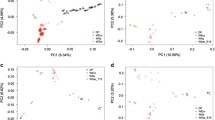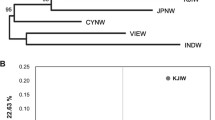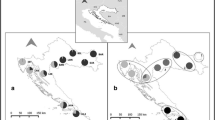Abstract
Over the last two decades wild boar Sus scrofa Linnaeus, 1758 became the most intensively managed game species in Bulgaria. In order to delineate the population genetic structure, which is essential for sustainable wildlife management, we screened 10 porcine microsatellites across 289 wild boar samples originating from all relevant bioregions of the country. Results based on F ST values, Bayesian clustering methods and a multi-dimensional scaling analysis can be summarised as follows: (1) two main genetic groups were revealed for the Bulgarian data set: the first one included individuals collected from the Balkan Range Mountain and the northern part of the country and the second one comprised individuals from the Rhodope, Osogovo, Iskur Range and Rila mountains in southern and south-western Bulgaria; (2) all Bulgarian wild boar populations showed a higher level of genetic diversity compared to four populations from Germany which were included for outgroup comparison, and (3) wild boar sampled from a game enclosure were found to be genetically divergent from the other Bulgarian populations, indicating human impact on population genetic structure most likely resulted from fencing and former translocation actions. The evolutionary background leading to the two defined management units as well as conservation and management strategies are discussed.
Similar content being viewed by others
References
Avise J. C. 1994. Molecular Markers, Natural History and Evolution. New York: Chapman & Hall: 1–541.
Brassel K. and Reif D. 1979. A procedure to generate Thiessen polygons. Geographical Analysis 325: 31–36.
Casgrain P. 2001. Development release of the R-package 4.0. University of Montreal, Montreal, Quebec. http://www.bio.umontreal.ca/Casgrain/en/labo/R/v4/tele charger.html
Cornuet J. M. and Luikart G. 1996. Description and power analysis of two tests for detecting recent population bottleneck from allele frequency data. Genetics 144: 2001–2014.
Danilkin A. A. 2001. The wild boar: an unprecedented spread or restoration of the species range? Doklady Biological Sciences 380: 457–460.
Dragoev P. 1978. Enriching Bulgaria’s game fauna. Zemizdat: 1–101. [In Bulgarian]
Evanno G., Regnaut S. and Goudet J. 2005. Detecting the number of clusters of individuals using the software STRUCTURE: a simulation study. Molecular Ecology 14: 2611–2620.
Feichtner B. 1998. Ursachen der Streckenschwankungen beim Schwarzwild im Saarland. Zeitschrift für Jagdwissenschaft 44: 140–150.
Food and Agricultural Organisation of the United Nations (FAO) 1996. Global project for the maintenance of domestic animal genetic diversity. Available at: http://www.fao.org/dad-is.
Genov P., Nikolov H., Massei G. and Gerasimov S. 1991. Craniometrical analyses of Bulgarian wild boar. Journal of Zoology, London 225: 309–325.
Goudet J. 2001. FSTAT, a program to estimate and test gene diversities and fixation indices. Version 2.9.3. Available at: http://www.unil.ch/softwares/fstat.html.
Guo S. W. and Thompson E. A. 1992. Performing The exact test of Hardy-Weinberg proportion for multiple alleles. Biometrics 48: 361–372.
Hartl G. B., Markov G., Rubin A., Findo S., Lang G. and Willing R. 1993. Allozyme diversity within and among populations of three ungulate species (Cervus elaphus, Capreolus capreolus, Sus scrofa) of South-eastern and Central Europe. Zeitschrift für Säugetierkunde 58: 352–361.
Hogan B., Constantini F. and Lacey E. 1986. Manipulating the mouse embryo: A laboratory manual. Cold Spring Harbor, New York: Cold Spring Harbour Laboratory Press: 188–196.
Ivanov H. 1906. [Wild boar]. Bulgarian Hunter 8: 49–50. [In Bulgarian]
Jakobsson M. and Rosenberg N. A. 2007. CLUMPP: a cluster matching and permutationprogram for dealing with label switching and multimodality in analysis of population structure. Bioinformatics 23: 1801–1806.
Journel A. and Huijbregts C. 1978. Mining geostatistics. Academic Press, London: 1–600.
Kuehn R., Schroeder W., Pirchner F. and Rottmann O. 2003. Genetic diversity, gene flow and drift in Bavarian red deer populations (Cervus elaphus). Conservation Genetics 4: 157–166.
Kuehn R., Haller H., Schroeder W. and Rottmann O. 2004. Genetic roots of eastern Swiss red deer (Cervus elaphus). Journal of Heredity 95: 136–143.
Kuehn R., Hindenlang K., Holzgang O., Senn J., Stoeckle B. and Sperisen C. 2007. Genetic effect of Transportation Infrastructure on roe deer population (Capreolus capreolus). Journal of Heredity 98: 13–22.
Lowden S., Finlayson H. A., Macdonald A. A., Downing A. C., Goodman S. J., Leus K., Kaspe L., Wahyuni E. and Archibald A. L. 2002. Application of Sus scrofa microsatellite markers to wild Suiformes. Conservation Genetics 3: 347–350.
Lucchini V., Meijaard E., Diong C. H., Groves C. P. and Randi E. 2005. New phylogenetic perspectives among species of South-East Asian wild pigs (Sus sp.) based on mtDNA sequences and morphometric data. Journal of Zoology, London 266: 25–35.
Manel S., Schwartz M. K., Luikart G. and Taberlet P. 2003. Landscape genetics: combining landscape ecology and population genetics. Trends in Ecology and Evolution 18: 189–197.
Manni F., Guerard E. and Heyer E. 2004. Geographic patterns of (genetic, morphologic, linguistic) variation: how barriers can be detected by using Monmonier’s algorithm. Human Biology 76: 173–190.
Mantel N. 1967. The detection of disease clustering and a generalized regression 16 approach. Cancer Research 27: 209–220.
Markov G. 1954. On the systematic of the wild boar in Bulgaria. Bulletin de l’ Institut Zoologique de l’Academie Bulgare des Sciences 3: 221–223. [In Bulgarian with English summary]
Monmonier M. 1973. Maximum-difference barriers: an alternative numerical regionalization method. Geographical Analysis 3: 245–261.
Piertney S. B., MacColl A. D. C., Bacon P. J. and Dallas J. F. 1998. Local genetic structure in red grouse (Lagopus lagopus scoticus): evidence from microsatellite DNA markers. Molecular Ecology 7: 1645–1654.
Piry S., Alapetite A., Cornuet J. M., Paetkau D., Baudouin L. and Estoup A. 2004. GENECLASS2: A software for genetic assignment and first-generation migrant detection. Journal of Heredity 6: 536–539.
Pritchard J. K., Stephens M. and Donnelly P. 2000. Inference of population structure using multilocus genotype data. Genetics 155: 945–959.
Rannala B. and Mountain J. L. 1997. Detecting immigration by using multilocus genotypes. Proceedings of the National Academy of Science of the USA 94: 9197–9201.
Randi E., Massei G. and Genov P. 1992. Allozyme variability in Bulgarian wild boar populations. Acta Theriologica 37: 271–278.
Raymond M. and Rousset F. 1995a. Genepop (Version-1.2) — Population-genetics software for exact tests and ecumenicism. Journal of Heredity 86: 248–249.
Raymond M. and Rousset F. 1995b. An exact test for population differentiation. Evolution 49: 1280–1283.
Rice W. 1989. Analyzing tables of statistical tests. Evolution 43: 223–225.
Rohrer G. A., Alexander L. J., Keele J. W., Smith T. P. and Beattie C. W. 1994. A microsatellite linkage map of the porcine genome. Genetics 136: 231–245.
Rousset F. 1997. Genetic differentiation and estimation of gene flow from F-statistics under isolation by distance. Genetics 145: 1219–1228.
Sáez-Royuela C. and Tellería J. L. 1986. The increased population of the wild boar (Sus scropha) in Europe. Mammal Review 16: 97–101.
Scandura M., Iacolina L., Crestanello B., Peccholi E., Benedetto M. F., Di Russo V., Davoli R., Apollonio M. and Bertorelle G. 2008. Ancient vs. recent processes as factors shaping the genetic variation of the European wild boar: are the effects of the last glaciation still detectable? Molecular Ecology 17: 1745–1762.
Schneider S., Roessli D. and Excoffier L. 2000. Arlequin: A software for population genetic data analysis. User manual version 2000. Genetics and Biometry Laboratory, University of Geneva, Switzerland, Geneva: 2000.
Sodeikat G. and Pohlmeyer K. 2003. Escape movements of family groups of wild boar Sus scrofa influenced by drive hunts in Lower Saxony, Germany. Wildlife Biology 9: 43–49.
Vernesi C., Crestanello B., Pecchioli E., Tartari D., Caramelli D., Hauffe H. and Bertorelle G. 2003. The genetic impact of demographic decline and reintroduction in the wild boar (Sus scrofa): A microsatellite analysis. Molecular Ecology 12: 585–595.
Weir B. S. and Cockerham C. C. 1984. Estimating F-statistics for the analysis of population structure. Evolution 38: 1358–1370.
Author information
Authors and Affiliations
Corresponding author
Additional information
Associate editor was Magdalena Niedziałkowska.
Rights and permissions
About this article
Cite this article
Nikolov, I.S., Gum, B., Markov, G. et al. Population genetic structure of wild boar Sus scrofa in Bulgaria as revealed by microsatellite analysis. Acta Theriol 54, 193–205 (2009). https://doi.org/10.4098/j.at.0001-7051.049.2008
Received:
Accepted:
Issue Date:
DOI: https://doi.org/10.4098/j.at.0001-7051.049.2008




